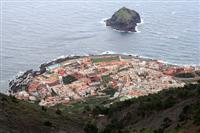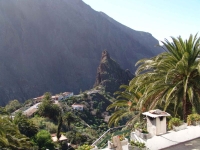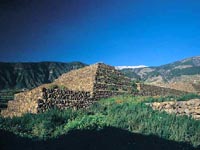
The town of Garachico offers a very different experience of Tenerife for those visitors wanting to see a more traditional and historical side to the island's character. Once a prosperous port town, Garachico suffered a weeks-long volcanic eruption in 1706 that destroyed the port but created rock pools that are today rich in marine life and perfect for swimming. The rock pools are a highlight of a visit to Garachico and make it a good destination for those travelling with kids. The village streets that fan out from the wonderfully picturesque main plaza, La Libertad, are narrow and cobbled, with restaurants and rustic buildings hiding around every corner. The old convent in the centre of town is open to visitors and well-worth checking out for its striking architecture. Garachico should delight photographers, particularly as it has retained its authentic character and charm, making it a refreshing break from the more homogenized resort areas. The drive to the village can be a bit stressful, because of all the curving little cliff roads, but the views more than reward the effort, and are considered some of the prettiest on the island.

The beautiful town of La Orotava is firm proof that there is much more to Tenerife than lovely beaches and a fun nightlife. Known for its aristocratic heritage and exceptional architecture, La Orotava is famous for its ornate balconies, many of which are concentrated on Casa de los Balcones. The town was settled by noble families in the aftermath of the Spanish conquest and they set about a flourish of competitive building, a legacy that modern-day visitors can enjoy at their leisure. The west of the island was home to Tenerife's nobility who built many fine houses. There are many churches and monasteries here too: don't miss the Gothic marvel of Iglesia de la Concepción. Other attractions in La Orotava include the theme park PuebloChico, which reproduces iconic buildings and landscapes of the Canary Islands in miniature. La Orotava is beautifully situated, with volcanic black beaches and mountains that encourage hiking and other outdoor activities. The perfect time to visit this picturesque town is during the festival of Corpus Christi, in early March, when the streets are decorated with carpets of flowers. This incredible and unique site draws visitors from all over the world.

This amazing animal park, both an aquarium and a zoo, in the north of the island is Tenerife's top attraction. The entrance fee is not cheap but considering you get a full day out, the ticket is good value. The dolphin and orca shows are particularly thrilling and the penguins even have their own glacier to cavort on. There are also sea lion and bird shows to enjoy. Animals in the park include gorillas, tigers, alligators, chimpanzees, jaguars, marmosets, otters, sloths, and meerkats, each in a lovingly maintained microclimate. The park was originally established as a sanctuary for parrots, and these colourful and characterful birds are still one of the highlights. For those planning on going to Siam Park, a combined ticket is available that provides a good discount on entry. There are several restaurants and bars in the park for rest and refreshments, but if you want to save money you can bring your own food and drink. For those watching the budget there is also a free train to catch from Puerto De La Cruz. Loro Parque has received numerous awards and generally receives rave reviews from visitors.
Address : Avenida Loro Parque s/n, Puerto De La Cruz
Website : www.loroparque.com
Telephone : +34 922 373 841
Opening times : Daily 8.30am to 6.45pm.
Admission : €38 (adults); €26 (children aged 6 to 11); children under 6 free.

The picturesque village of Masca is found on the northwest tip of Tenerife. Sitting in the Teno Mountains, it clings to the slopes of a deep, green ravine beside a narrow road full of alarming hairpin bends. The zigzag drive from Santiago del Teide has opened up the village and its magical setting, reputed to have once been a pirate's hideaway. The village has a little market and some restaurants as well as accommodation options but its main selling point is the spectacular scenery. Hikers have popularised a two-hour walk, from the village through a gully to the sea at the base of the majestic cliffs of Los Gigantes. The hike is a glorious way to experience the landscapes, but is not suitable for those afraid of heights as things get rather steep. Once you reach the beach you will find a picturesque bay with black volcanic sand and clear water which is lovely for a picnic, a swim, and a snorkel. In summer there are water taxis transporting people between this bay and Los Gigantes every two hours or so.

This park is a sure-fire hit with kids and a must for animal lovers of all ages. Monkey Park is a privately-owned conservation and breeding centre for endangered animals, specialising in primates, and doesn't put on any animal shows, aiming rather to educate visitors and let them enjoy interacting naturally with the animals. The park is home to a quirky variety of monkeys, parrots, iguanas, giant tortoises, lemurs, crocodiles, and other curious creatures. Some animals are in enclosures, but others, most notably the comical and friendly lemurs, are allowed to roam free and interact with visitors. The best way to make sure you're popular with the animals is to bring fruit for them to eat. There is feed for sale at the ticket desk, but grapes are a favourite. It's also a good idea to bring refreshments for yourself as the only snacks and drinks available are from vending machines. Families should cater to spend at least two to three hours in the park, which is small but will delight children. The park is off the bus route so a taxi or hired car is needed to get there.
Website : www.monkeypark.com
Telephone : +34 922 790 720
Opening times : open daily 9.30am to 5pm.
Admission : €10 (adults); €5 (children aged 5 - 12).

On the east coast of Tenerife, south of Santa Cruz, stand six mysterious step pyramids of which archaeologists have yet to discern the origin. The pyramids were initially thought to be the remains of agricultural stone terraces, or random piles of stone cleared from fields by early Spanish settlers. However, Thor Heyerdahl, the Norwegian anthropologist who lived in Guimar on Tenerife until his death in 2002, thought differently. His research indicated that the pyramids were constructed on similar principles to those in Mexico, Peru and ancient Mesopotamia. The pyramids are now enclosed in an Ethnographic Park; the site includes a museum, life-size replica of Heyerdahl's reed ship Kontiki, a cafeteria, and souvenir shop. The structures remain the subject of some debate among archaeologists, and the first real excavation of the pyramids, in 1991, didn't reveal anything to help definitively date them. The park, however, is lovely, and is of botanical as well as archaeological interest, with paths winding through miles of Canarian vegetation. There is also a Secret Garden dedicated to poisonous plants. There are picnic areas dotted around the park and it is a good idea to bring a picnic to fully enjoy the area.
Address : Calle Chacona, Guimar
Website : www.piramidesdeguimar.es/en-US/index.aspx
Telephone : +34 922 514 510
Opening times : Daily from 9.30am to 6pm
Admission : Variety of ticket options available. General entry: €11 (adults); €5.50 (children aged 9-12); children under 9 free.

Siam Park provides is an exciting waterpark with Thai-themed rides. Its presentation is excellent and the rides are numerous and world-class. Lazily float down the Mai-Thai River or take the challenge of the Tower of Power which has a 28-metre vertical drop. There is a big beach area and a wave pool and a special watery playground area for small children. The Floating Market, styled like a Thai village, has shops and restaurants and even offers spa treatments for those who would rather be pampered. There are some nice touches, like the sea lion enclosure, where you can watch the animals at play, and a shark tunnel and some rapids as an optional extra on the lazy river. The park is very popular and in the summer months the queues do get long. It is recommended that you book your tickets in advance online to skip the entrance queue. There are things like lockers and sun loungers available for rent. A free bus runs from Los Cristianos, Las Americas, and Costa Adeje. Siam Park should provide a fun day out for people of all ages and is especially good for entertaining teenagers.
Address : Autopista TF1, Salida 28, Costa Adeje.
Website : www.siampark.net
Telephone : +34 922 060 000
Opening times : Open daily from 10am to 6pm (May to October); 10am to 5pm (November to April).
Admission : €38 (adults); €26 (children aged 3 - 11).
The spectacular Parque Nacional de las Canadas del Teide was declared a protected area in 1954, including an enormous volcanic crater with a circumference of 30 miles (48km) out of which rises the highest peak in Spain, Mount Teide. It is the largest, one of the oldest, and the most visited national park in Spain and has been declared a UNESCO World Heritage Site. Since 2007, it has also been one of the 12 Treasures of Spain. In contrast to the coastal regions of Tenerife, the temperatures in the reserve can be extreme: winter in the park, which lies at about 6,562ft (2,000m) above sea level, brings snowfall and gale force winds, while in summer temperatures can soar to above 104ºF (40ºC). A cable car carries visitors to the summit of Mount Teide, but many prefer to hike the route to experience the flora and fauna, including rare specimens like the violet of the Teide, the Tajinastes, as well as the many varieties of lizards and birds. There is a refuge near the summit which you can book to stay in, and reserving this accommodation includes the permit you will need to climb Mount Teida.
Opening times : Cable car operates between 9am and 4pm daily, weather depending

The volcanic nature of the island of Tenerife means that the land has few natural beaches. Those that exist are characterised by black shingle stretches created from the island's volcanic rock foundations. The demand for tourist sun-bathing space, however, has led to the creation of resorts and man-made beaches, with golden sand having been imported in some cases. Many of the beaches of Tenerife have been awarded the European Blue Flag for their cleanliness and the quality of their sand. The good beaches on Tenerife for sunbathing and soft sand are Los Gigantes and San Juan in the west; and Fanabe, with its yellow sand, showers, and other facilities, located to the south. Also popular are Torviscas with its marina, Playa las Americas for its grey sandy stretches, the soft yellow expanse of Los Cristianos' beach, Las Vistas, and Los Cristianos. Candaleria in the east has a small black shingle beach. Up north Puerto de la Cruz has a beach with fine black shingle, but at Santa Cruz has imported golden sand. Although the imported white sand is ideal for sunbathing, the black volcanic beaches of Tenerife can be very beautiful and are often less crowded.

Travel Guide powered by Word Travels, copyright © 2023 Globe Media Ltd. By its very nature information in this travel guide is subject to change at short notice and travellers are urged to verify information on which they're relying with the relevant authorities. Neither Globe Media Ltd nor Travel Vogue can accept any responsibility for any loss or inconvenience to any person as a result of information contained above.